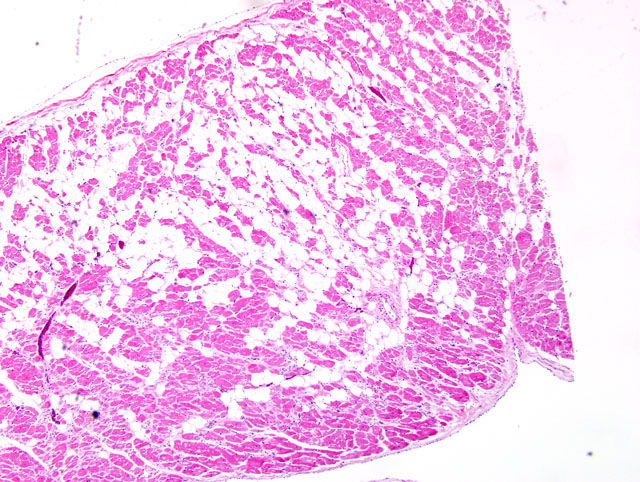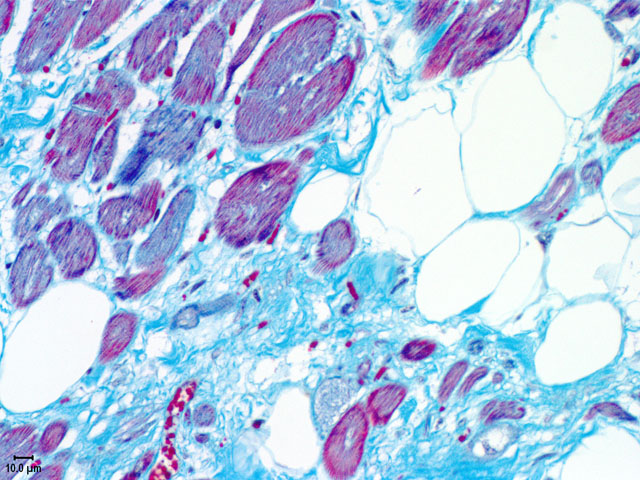Signalment:
6-year and 7-month-old, female, spayed boxer dog (
Canis familiaris).
No history of prior illness, current on vaccinations and preventative medicine. Found dead two hours after vigorous exercise.
Gross Description:
There were a small number (10-15) of scattered petechial hemorrhages on the epicardial surface of the heart.
Histopathologic Description:
The right ventricular wall is severely infiltrated by individual and small aggregates of well differentiated adipocytes which replace approximately 50-60% of the cardiomyocytes. There is multifocal moderate atrophy of the remaining cardiomyocytes and regionally extensive interstitial fibrosis. These changes are most severe in the subepicardial region of the ventricular wall. The right atrium and interventricular septum are similarly, but less severely, affected.
Morphologic Diagnosis:
Heart: Chronic moderate myocardial atrophy and interstitial fibrosis with replacement by adipocytes.
Condition:
Arrhythmogenic right ventricular cardiomyopathy (ARVC)
Contributor Comment:
These histologic findings are consistent with arrhythmogenic right ventricular cardiomyopathy (ARVC). ARVC is a variant of dilated cardiomyopathy (DCM), which occurs in boxer dogs, cats and humans. It is characterized histologically by severe myocyte atrophy in the right ventricular free wall and replacement by adipocytes and/or fibrous tissue. Replacement extends from the epicardial surface and extends towards the endocardium. Occasionally, the left ventricle and interventricular septum may also be involved.(1,5-7) Two variants exist: fatty and fibrofatty forms. The fatty form consists of multifocal regions of adipocyte replacement within the right ventricular wall accompanied by a mild interstitial fibrosis. The fibrofatty form is characterized by focal-diffuse regions of myocardial replacement by adipose tissue and marked fibrosis.(1) The disease in dogs closely parallels that seen in humans; loss of right ventricular myocytes with replacement by fat or fibrofatty tissue is considered the pathologic hallmark of human ARVC.(1) Clinical signs of ARVC may include ventricular arrhythmias, syncope, heart failure or sudden death. A spontaneous form of ARVC is also seen in cats, although unlike in dogs and humans, sudden death is not a feature of the disease.(3,4)
ARVC is thought to be transmitted as an autosomal dominant trait in both boxer dogs and humans, although an autosomal recessive trait has also been identified in humans. In humans, mutations in the genes coding for various intercellular adhesion proteins, components of the sarcoplasmic reticulum calcium channel and cytokines have been implicated in the pathogenesis of ARVC.(2) To date, published reports of homologous genes in the dog have failed to identify equivalent mutations.(8,10) However, a seven base pair deletion within the non-coding regulatory sequence of a calcium modulating gene on chromosome 17 has recently been identified as responsible for ARVC in boxer dogs.(9) Although precise information regarding this mutation has not yet been released into the public domain, Washington State University College of Veterinary Medicine now offers a genotyping service for canine ARVC
(http://www.vetmed.wsu.edu/deptsVCGL/Boxer/test.aspx).
JPC Diagnosis:
Cardiomyocyte degeneration, necrosis, and loss, multifocal, marked, with fibrofatty infiltration.
Conference Comment:
There is some variation within the sections, with most participants slides having a predominantly fatty infiltrate, while in a few slides, adipocytes are accompanied by a small amount of fibrosis (i.e. fibrofatty infiltrate) and rarely, a mononuclear cell infiltrate. This is interesting considering the sudden death of the dog in this case, because in one study of 23 boxer dogs with ARVC, of the nine dogs that died suddenly, all had myocarditis in the left and/or right ventricle, and six had the fibrofatty form. Of the 14 dogs with ARVC that did not die suddenly, only seven had myocarditis, and only two had a fibrofatty infiltrate. Myocarditis may lead to arrhythmias that cause sudden death. In cats, the fibrofatty form predominates, but sudden death is not a feature of ARVC in felids.(1) Dilated cardiomyopathy (DCM), of which ARVC is one variant, is the most common canine cardiomyopathy, with a number of large- and giant-breed dogs being predisposed. An infantile form in Portuguese water dogs is inherited as an autosomal recessive trait, while an X-linked recessive gene is suspected in Great Danes. Nutritional deficiencies (e.g. taurine and carnitine deficiency) and endocrinopathies (e.g. hypothyroidism) have also been associated with DCM. Less common in dogs are hypertrophic cardiomyopathy, characterized by disproportionate interventricular septal thickening and myofiber disarray, and canine X-linked muscular dystropy, a disease of golden retrievers characterized by subendocardial interstitial fibrosis.(6)
References:
1. Basso C, Fox PR, Meurs KM, Towbin JA, Spier AW, Calabrese F, Maron BJ, Thiene G: Arrhythmogenic right ventricular cardiomyopathy causing sudden cardiac death in boxer dogs: A new animal model of human disease. Circulation
109:1180-1185, 2004
2. Corrado D, Basso C, Thiene G: Arrhythmogenic right ventricular cardiomyopathy: an update. Heart
95:766-773, 2009
3. Fox PR: Arrhythmogenic right ventricular cardiomyopathy.
In: Consultations in Feline Internal Medicine, ed. August JR, vol. 5, pp. 319-322. Elsevier, St. Louis, Missouri, USA, 2006
4. Fox PR, Maron BJ, Basso C, Liu SK, Thiene G: Spontaneously occurring arrhythmogenic right ventricular cardiomyopathy in the domestic cat: A new animal model similar to the human disease. Circulation
102:1863-1870, 2000
5. Harpster N: Boxer Cardiomyopathy.
In: Current Veterinary Therapy, ed. Kirk RW, 8th ed., pp. 329-337. W. B. Saunders Co., Philadelphia, USA, 1983
6. Maxie GM, Robinson WF: Cardiovascular system.
In: Jubb, Kennedy and Palmers Pathology of Domestic Animals, ed. Maxie GM, 5th ed., vol. 3, pp. 48-49. Elsevier, Philadelphia, USA, 2007
7. Meurs KM: Boxer dog cardiomyopathy: an update. Vet Clin Small Anim
34:1235-1244, 2004
8. Meurs KM, Ederer MM, Stern JA: Desmosomal gene evaluation in Boxers with arrhythmogenic right ventricular cardiomyopathy. Am J Vet Res
68:1338-1341, 2007
9. Meurs KM, Mauceli E, Acland G, Lindblad-Toh K: 2009 ACVIM forum and Canadian veterinary medical association convention, abstract #11: Genome-wide association identifies a mutation for arrhythmogenic right ventricular cardiomyopathy in the boxer dog. J Vet Intern Med
23:687-688, 2009
10. Oyama MA, Reiken S, Lehnart SE, Chittur SV, Meurs KM, Stern J, Marks AR: Arrhythmogenic right ventricular cardiomyopathy in boxer dogs is associated with calstabin2 deficiency. J Vet Cardiol
10:1-10, 2008

